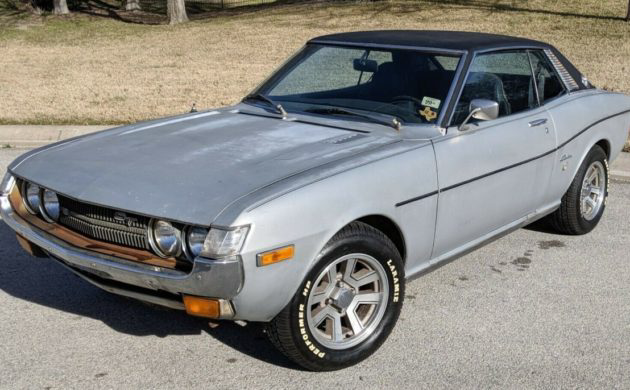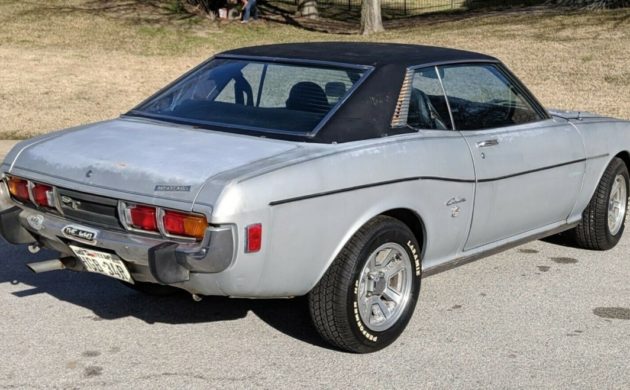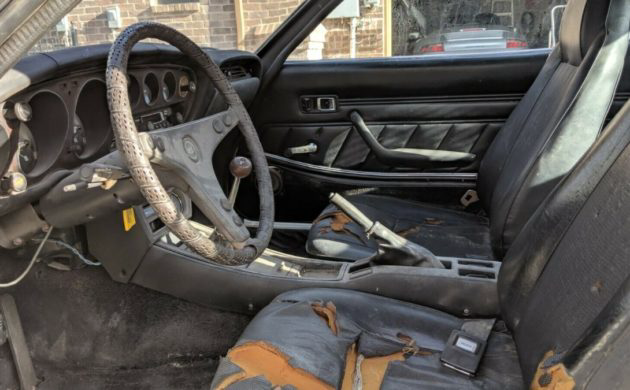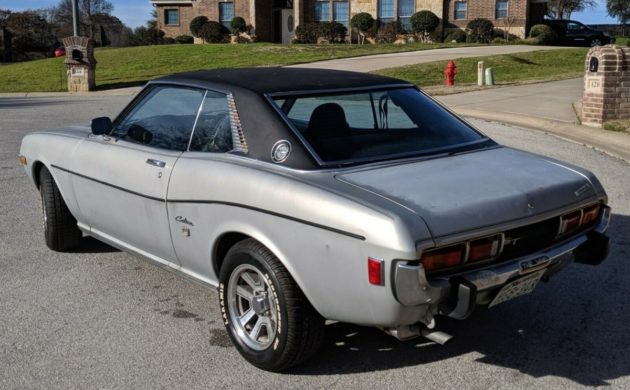Don’t be fooled by the faded and baked appearance, because this 1973 Toyota Celica is a solid and rust-free Japanese classic that is just begging to be restored. They can be an enjoyable little car to own and drive, and not only are they notoriously mechanically robust, but parts remain readily available. There are also a multitude of parts available that will potentially provide some substantial improvements in performance if that’s what the next owner desires. If you would like to become that next owner, you will find the Celica located in Fort Worth, Texas, and listed for sale here on eBay. Bidding has reached $4,500, and with the reserve now met, this little car is set to head to a new home.
The Silver Metallic paint on the Celica is looking pretty baked, while the same would appear to be true of the Black vinyl top. Many Japanese cars of this era could be prone to rust issues, but those from Toyota seemed to be the best of the bunch when it came to avoiding problems. This one looks like it is very solid, and a life spent in Texas has undoubtedly helped its cause. The owner does state that it is rust-free, and there is nothing evident in the supplied photos. The panels also look to be extremely straight, with a crease in the hood being the only significant damage. There are a few dings below the rear bumper, but the rest of the car looks good. In fact, with no rust and few panel issues to tackle, this would appear to be the sort of restoration project that could easily be tackled in a home workshop. The Celica does wear a set of 14×7 Supra wheels, and whether these stay or go will be a matter of personal preference for the next owner.
Under the hood of the Celica, we find the bulletproof 1,964cc, 18R-C 4-cylinder engine, backed by a 4-speed manual transmission. This powerplant could pump-out 97hp in good health, allowing the vehicle to accelerate from 0-60mph in around 11.5 seconds. Mechanically, the news seems to be largely good with this car. The revival process after 20-years in storage has included flushing and cleaning the fuel tank, rebuilding the carburetor, replacement of both the clutch and brake master cylinders, along with the fitting of a new clutch slave cylinder. A full fluid flush and service was also performed, while a new distributor was fitted, and a multitude of other parts have been installed. The owner states that the front end will require a rebuild, but it appears that all of the parts for this are included in the sale. He says that the car runs and drives okay, although the carburetor refuses to come back to a decent idle level. He suggests that upgrading this to a Weber might be a good move, and it wouldn’t be the first time that this has happened to a Celica. Of course, if more horsepower is what the next owner desires, then slotting an 18R-G under the hood might be an option. This 1,968cc engine features a twin-cam cylinder head developed in collaboration with Yamaha and would boost power output to a very healthy 143hp. This is an extremely common transplant, and if allied to the fitment of a 5-speed manual transmission, it can really make a Celica get up and moving. Of course, you would have to check the legality of such a change with regard to emission laws in your area.
Everything in life is a compromise, and the sort of dry and warm environment that minimizes rust can have a dramatic impact upon other areas of a classic car. Nowhere is this more obvious in the Celica than when we take a look around the interior. The best thing that I can say about it is that it does appear to be both complete, and largely unmodified. Beyond that, it has deteriorated badly and will require a full restoration to return it to its best. Items such as the console and dash look like they could be restored, and while the door trims are presentable, they have been cut to fit aftermarket speakers. The rest of the upholstery is heavily toasted, and the next owner might have some trouble finding a full trim kit. However, the vast majority of the parts required are available individually. While some of these parts aren’t cheap, I was able to put together a collection of parts across several suppliers that gave me everything but new seat covers, and the cost was around $1,500 for the lot.
As a restoration project to be tackled in a home workshop, this 1973 Celica appears to be a good one. In fact, with a little bit of tinkering, it looks like the sort of car that could be driven and enjoyed fairly easily. These early Celicas have developed a strong following in recent times, and while it doesn’t promise to be a car that will be worth a small fortune in the future, it should still hold its value quite well. It is a car that I wouldn’t mind having in my workshop. How about you?







I really like these 1st gen Celicas, but one must admit, what a rough one. The only thing going for it, is it is kind of rust free, these didn’t last long up north. One dose of salt was all it took, and in 5 years max, they were too far gone to be safe. For something with this amount of work, you’d think it would be nicer, and the high idle is probably a vacuum leak, very common with these. It’s a good find, only because they are so rare today, but the interior is the worst and a big job to get it right.
I’m surprised the quick rusting did not kill/ruin Toyota, Datsun, etc. in this country, since this quick rusting occurred for decades!
Must have been the better mpg than domestic cars.
Was the quick rusting due to bad steel or little/no/improper hidden metal surface priming & painting?
Can one actually strip the body of a good survivor & rustproof it like new cars with modern sprays, etc.?
By the standards of the time it was only somewhat worse than average. Chevy Vega, Ford anything, and don’t forget Fiats of this time could all rust like it was an Olympic sport.
I’m sure it was well known how long they would last. The metal was paper thin, and probably of poor quality to begin with. I heard, Asian car makers imported all their steel from us, ground up ’65 Chevy’s and such, and was poorly treated. I heard a rumor, it’s the same reason square body GM trucks rusted so fast, is because we bought our ground up steel from them, because it was cheaper. If cars never rusted, they’d be out of business in no time.
Least we forget the Lancia Beta (same time frame) … where it was condemned, and actually recalled and crushed by Lancia, when rust ate away the subframe carrying the engine and gearbox. The box section to which the rear of the subframe was mounted could corrode badly, causing the subframe to become loose
No Howard, some of these would actually last up North as there were some states that didn’t salt the roads and mag chloride wasn’t being used yet. You may also like to know that not everyone used them as winter transportation since they were worthless in deep snow. Ask me how I know.
Have a 1978 GT that I’ve had here in Idaho for over 30 years and yes, rust free! Parked most of winter now, but a fantastic car, still love every time I drive it!
Nice to look at and nice to sit in but S……L……O……W as molasses on a winter day. Had one of these back in the late 70s and had a hill to climb coming out of my apartment complex once I hit the main road. Getting it to highway speed with the a/c running meant waiting until you cleared the top of the hill. Can’t see spending the current bid price and then having to put another $10k+ in it to upgrade the paint, interior, and engine. Nope, pass on this one.
I had so much fun with these cars back in the early 80’s. Yes they did rust easily but could not blow it up if you tried and I tried! I had a ’75 and ’76 model, both white with manual trans. They were fun in the snow too!
I have a very clean 74 Celica like this. I might add that body parts are unobtanum. I have been looking for a rust free right side fender for my Celica for several years. Fiberglass is but looking for metal.
One thing that amazes me is these vintage Celica’s (or it seems any Japanese car) gets instant respect no matter what with the tuner crowd. Had mine to a cars and coffee and kids in their 20’s are all over it. When I drive it always get a wave, thumbs up etc. These are still fun cars that are appreciating rapidly. It is an old car that has aged gracefully. No matter how long it sits in the warehouse. It always starts right up just like a Toyota.
“Running when parked, ran out of gas in early 2000, bring your own can.”
Love it. I had a ’74 and the only thing to really pay close attention to on these is the timing chain – ask me how I know…
Excellent car. Swap the motor for one of the 2 liter 3T or 4T motors with a 5 speed and it’s imminently driveable. Ditch that junk US emissions motor.
My first car was the last year for the first-gen Celicas (’77 GT Liftback). Lemon yellow with butterscotch interior. Bought it for $3K with 70K miles in 1984, drove it between Southern CA and Maryland eight times (college) and sold it in 1990 with 168K miles for $500. Even with an Infiniti SUV daily driver and a ’94 Mazda RX7 R2 for weekend joy rides, I still miss that car.
“….parts remain readily available.” Excuse me? Not in this solar system they don’t
I thought I had to have one of these back around 1980. Seriously this one is in better shape today than most of them I looked at in 1980! I seem to recall that one of the engines in these had an issue with the “balance shaft” need to be either replaced, or supposedly you could just remove it and live with some vibration. (hopefully someone can expand on that statement). After driving a few (admittedly not in great shape), I turned my attention to the Mercury Capri (Cologne V6) which was not as sexy, but IMO much more fun to drive.
My first car was a 76 Celica GT coupe in this exact same color. I miss that car.
My guess is that it was originally a So Calif car based on the KLOS teutonic look “The WHO” bumper sticker.
Also – factory A/C is rare…
I certainly dont share in any of the disappointment, i think this is a huge find, while im a Subaru guy and would opt for a rust free( ish) gl gl10 instead of a yota, the yota is a great rig, most are soup cans. To me , looking close i see Challenger lines, i like these i like the early mazdas too, But have faith in the Roo( yea the disposable era) great job BF
This brings back great memories, my dad bought a new ST in 72, save for the US bumper mandate after 74, the 1st generation Celicas were the best. Unfortunately living here in the Midwest, you could sit on the front porch and watch it rust. I’d like to think this is a fair buy, but I’m thinking Suprarossa says it best as far as parts obtainability. That’s too bad, cause this is an awesome canvas to start with.
mileage on the clock shows 43k…..i call fraud—-with the brake and clutch pedal wear ,i am saying 143k for miles….the ST was the low budget entry-level Celica as well—–the GT was nicer as well—-gotta pass on this time capsule sled–
Don’t quote me on this, but I don’t think the GT was available until 74. I know for a fact that it wasn’t in 72, but not sure about 73.